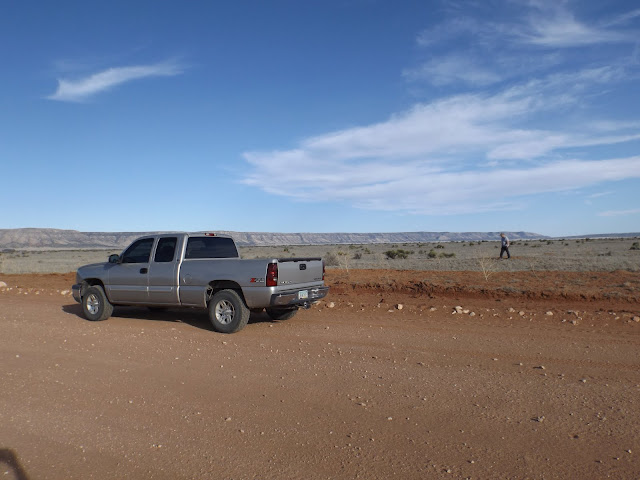Here is Part 2 of my Black-footed Ferret spotlighting journey. Enjoy!
Last time on Adam's Command:
My Dad and I joined up with the AZGFD to attend a Black-footed Ferret Spotlighting Event in Seligman, AZ. We found an Ord's Kangaroo Rat, two rabbit species, and a possible American Badger but no ferrets! We did get to see the only ferret that had been captured, anesthetized, and vaccinated. After a long night's morning, we retreated into our motel room not to wake until 2 pm...
- Day 2 -
Feeling slightly refreshed, we decided to return to the Aubrey Valley to check it out during the day. We especially wanted to see Gunnison's Prairie Dogs, the Black-footed Ferrets' primary prey. Take a look at these photos of the valley...
 |
| This long stretch of cliffside outlines the northern border of the Aubrey Valley. |
We were in the valley no more than 5 minutes until we spotted our first Gunnison's Prairie Dog! It was standing in its hind feet to scan the area for predators such as Red-tailed Hawks and Golden Eagles.
We saw multitudes of these glorified ground squirrels scattered along the road.
 |
| The iconic pose of the Gunnison's Prairie Dog |
We also found a small herd of Pronghorn - all of whom were female. I recently learned that Pronghorn mothers eat their young's feces! I was very confused as to the reasoning behind this behavior until my geography teacher explained why. Towards the end of the ice age, Pronghorn were the American Cheetah's primary prey. These cats had an excellent sense of smell, and guess what? They could smell junior antelope's poo from afar! Thus, Momma Pronghorn thought it would be safer to eliminate the odor altogether! Also, Pronghorns are very flighty and can run up to 60 mph. Nothing else in North America can run nearly that fast, oh, except for the now-extinct American Cheetah!
Bird wise, Horned Larks were abundant as were Common Ravens and Western Meadowlarks. I also encountered Loggerhead Shrikes, one my all-time favorite birds. The most interesting species present, however, were the Sage Thrashers. Seven of them to be exact! It was pretty interesting to see so many at once. I didn't realize how gregarious they could be during migration. The Aubrey Valley has been designated as an IBA (Important Bird Area). It is home to a significant route for migrating raptors. Jennifer Cordova mentioned that a kettle of over 150 migrating Turkey Vultures had been seen recently.
 |
| These Horned Lark tracks were abundant in the soft sandy soil |
 |
| The deadly "headstand' of foulness |
 |
| Darkling Beetles have fused elytra - they can't fly |
 |
| The main road to Pica Camp - the grand cliffside in the background |
 |
| One of many prairie dog burrows |
 |
After our productive stop in the Aubrey Valley, my Dad and I decided to get a few more hours of sleep before resuming the nightly grind. After our nap, it was 8pm and we headed west to the AZGFD processing trailer to receive info on our new route and also to get a map and observation form. We were there earlier than most of the other volunteers. We kept awake by drinking soda and snacking. We encountered nothing unusual until about 11pm when we reached an area with sparse junipers. I heard a faint clicking sound in the sky above us. It was a bat! My Dad also got to hear it. I never tire of hearing or seeing bats. They are difficult to study and not frequently seen. Later, I asked Jen Cordova what if could have been; she said that the typical vocalizing bat here is the Big Brown Bat.
We traveled far and wide in our search for the elusive Black-footed Ferret and decided to call it quits at 4am. Little did I know that no one else had seen any ferrets whatsoever that night also. As we were leaving, I kept spotlighting the roadside and I saw a strikingly patterned pocket mouse run into a burrow! I left the car with my cordless spotlight and checked out the holes it could have entered.
 |
| One of several burrow entrances that the pocket mouse uses |
According to habitat, location, and the pattern of the animal, Silky Pocket Mouse would be the only eligible candidate. This was the last animal of the trip. The total counts for ferrets were devastatingly low, but is mostly due to the fact that numbers are down in the spring typically. I could do this again in the summer or fall when its warmer. I full-heartedly hope that the species is doing well here and in the other states and I fully intend to capture one next time!!!
Godspeed and good birding,
- Joshua
















Nice post, Josh! The grasslands of AZ hold an amazing diversity of animals don't they?! I like your Prairie-Dog photos!
ReplyDeleteThanks Caleb! Those grasslands are pretty diverse. Especially when it's 22 degrees at night! I bet you'd enjoy this event! The biologist did say they have had Short-eared Owls!
Delete